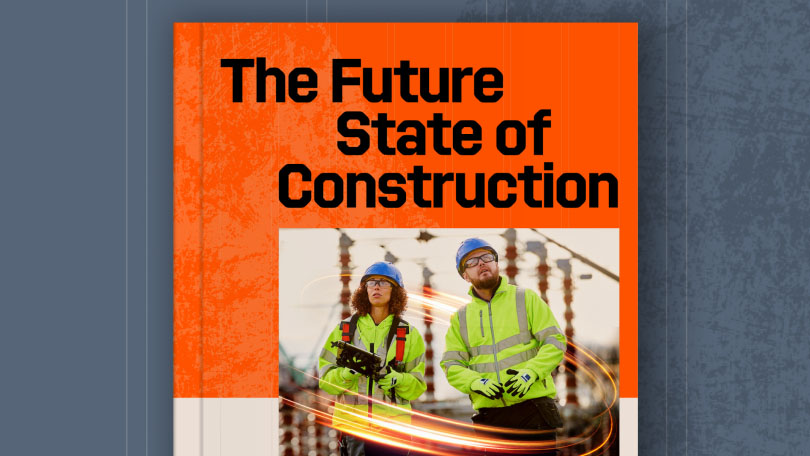— 10 min read
Construction Estimating: Building Blocks to Success

Last Updated Sep 23, 2025

Brendan McGurk
Strategic Product Consultant - Construction Financials
21 articles
"Brendan is a Strategic Product Consultant for Procore Financials, where he enjoys leading and innovating internal company processes to deliver on both public and private projects. He brings 12 years of experience working in various construction roles ranging from builder's hand to quantity surveyor and project manager on both the owner and main contractor side.
Originally studying Accounting, he changed direction to quantity surveying after the Christchurch Earthquake in 2011. He is now qualified and an NZIQS-recognised Quantity Surveyor. He’s since worked on projects from feasibility, concept design, and value engineering right through to construction and post-construction support.

Nicholas Dunbar
Content Manager
62 articles
Nick Dunbar oversees the creation and management of UK and Ireland educational content at Procore. Previously, he worked as a sustainability writer at the Building Research Establishment and served as a sustainability consultant within the built environment sector. Nick holds degrees in industrial sustainability and environmental sciences and lives in Camden, London.

Zoe Mullan
27 articles
Zoe Mullan is an experienced content writer and editor with a background in marketing and communications in the e-learning sector. Zoe holds an MA in English Literature and History from the University of Glasgow and a PGDip in Journalism from the University of Strathclyde and lives in Northern Ireland.
Last Updated Sep 23, 2025

Construction estimating is a key process in the construction industry, accurately predicting project costs before work begins. Throughout the United Kingdom, trained estimators and quantity surveyors carry out construction estimating, specialising in cost estimation and management.
Table of contents
Understanding Construction Estimating
Construction estimating evaluates all costs associated with a specific construction project. These costs generally include direct and indirect expenses, overhead, and mark-ups:
Direct Costs
Funds allocated toward construction process aspects such as materials, labour, and equipment.
Indirect Costs
Any costs not directly associated with construction activities – utilities, quality control, administration, permits, security, legal fees, etc. (often called 'prelims').
Labour Hours
All costs associated with actual project construction, including wages, loaded on-costs, and potential overtime.
Subcontractor Expenses
Estimated expenses for duties outsourced to subcontractors, including labour, materials, and equipment.
Professional estimators must conduct construction estimates properly during the preconstruction phase. Ideally, qualified estimators provide accurate estimates with valid cost reasoning while identifying risks by drawing on skills and experience. Moreover, UK estimators benchmark against the RICS New Rules of Measurement (NRM 1-3)to ensure consistency.
Learn more: Understanding the 6 Phases of Construction Project Management
Why Estimating Matters in Construction
Construction estimating is important because it helps both owner-developers (and/or clients) and contractors determine project feasibility within allocated budgets. It also allows stakeholders to decide whether value engineering – improving value while reducing costs – needs to be implemented. This process can reveal whether additional funding is required. Stakeholders can complete these steps before tendering or during the early-contractor-engagement phase.
Accurate estimates are the first line of defence against cost overruns, enabling professionals to price, quantify, or transfer risk items before contract award.
Once the client feels satisfied with the indicative price, they can either:
- Provide quantities, plans, and supporting documentation (specifications) to main contractors for pricing the required scope, or;
- Allow potential main contractors to complete their own take-offs and estimates as part of the tender stage.
Preparing an accurate estimate helps lead contractors understand the true bottom line of completing a project. However, this comes with the caveat that contractors, eager to secure new business, often take aggressive approaches.
Additionally, contractors rely on accurate estimates to submit competitive, profitable tenders. Should they win a project only to discover they underestimated the budget – or failed to consider the full scope of works or potential risks – profitability suffers. Similarly, over-estimating may result in rejection because the price exceeds competitors' offerings.
Finally, when negotiating during tendering, an accurate estimate ensures that both owner-developers and contractors profit equitably from the outcome.
8 Steps to Successful Estimating
Whether a construction estimator works for a main contractor, subcontractor, or owner-developer, they typically follow the same process.
1. Review the Tender Package
The tender package contains all documents necessary for submitting a tender: owner-contractor agreements, bond forms, general conditions, supplementary conditions, and construction specifications. Since contractors who tender on a project must complete the work specified in the tender package, estimators must familiarise themselves with every aspect of the project to submit accurate estimates.
The package also includes drawings – technical illustrations that visually represent construction project specifications. Estimators often subdivide drawings by purpose: architectural, structural, mechanical, electrical, and plumbing. They can also group these into packages depending on tender engagements.
Learn more: Construction Tendering: Process, Types and Importance
Although main contractors and subcontractors review the same documents, subcontractors often refer only to those relevant to their work.
Estimators follow these steps when reviewing a tender package:
- Ensure all drawings and specifications are present and current, and cross-check revision dates
- Gain an overview of project scope, including material needs and quality of finishes
- Evaluate package requirements by reviewing engineering and specific drawings
- Consider MEP needs and how they may influence sequencing
- Identify any non-standard items or unusual finishes
- Review the Pre-Construction Information (PCI) pack for residual health-and-safety hazards under CDM 2015
Throughout the estimating process, estimators continually refer to tender documents to ensure their estimates cover every aspect of the specifications and requirements.
After reviewing documents, main contractor estimators also subdivide projects into work packages for subcontractors or their own labour.
By reviewing technical specifications ('specs'), estimators can clearly see work scope according to various divisions of the UK National Building Specification (NBS) format: concrete, masonry, metals, finishes, plumbing, etc.
For instance, an estimator may create a package that includes materials and labour for rough-in plumbing tasks, and another covering windows and installation. A single project may contain multiple packages.
Dividing projects into work packages requires diligence. Therefore, estimators must ensure they:
- Include every aspect of the project in a package – omitting work leaves contractors exposed
- Avoid assigning the same work twice – duplicated scope inflates tenders
- Clearly define each package's scope
Once estimators divide all work into packages, main contractors can request tenders from subcontractors for either portions of, or all, required works.
2. Visit the Construction Site
Depending on tender requirements, site visits may be mandatory or voluntary. Nevertheless, good estimators should always attend; visits provide insights beyond elevation drawings and photographs. The exception may be specialist subcontractors who can rely on documentation provided by clients or main contractors.
Site visits help estimators understand conditions that may influence costs. Complexity may increase if sites have:
- Poor drainage, difficult subsurface soil, or adjacent buildings
- Access constraints affecting equipment movement and deliveries
- Poorly located utilities necessitating underground works
- Restrictions on working hours, storage, or noise
- BREEAM sustainability targets or Part L energy-efficiency requirements that dictate material performance
Estimators should arrive with checklists and clarify uncertainties – never assume, always ask. They should also consider:
- Local planning requirements and permits
- Availability of subcontractors, plant hire, and materials
- Road suitability for heavy deliveries
For construction estimators, site visits provide invaluable ways to assess construction project costs and feasibility. In turn, this results in more accurate construction estimates.
3. Perform a Material Take-off
Also called a 'quantity take-off', material take-offs measure materials and labour required to complete projects. Estimators review documents and count every item:
- Quantity or count (doors, hardware)
- Area (e.g., internal wall linings, flooring)
- Volume (e.g., bulk excavation)
- Length (e.g., handrails)
- Sum (permits)
In the UK, measurement follows the RICS Standard Method of Measurement. For guidance, contact RICS or the Chartered Institute of Building (CIOB).
On large projects, clients or engineers may issue Bills of Quantities (BOQs) to simplify tender levelling. Even then, contractors perform their own take-offs to verify quantities and raise Requests for Information (RFIs).
Download our free Bill of Quantities template to speed up take-offs and tender reconciliation.
After take-offs, estimators possess comprehensive lists of materials and equipment required for each package. Many now use cloud-based estimating platforms linked to BIM models, reducing manual entry and errors.
4. Solicit Pricing from Suppliers and Vendors
Once subcontractors have definitive material and equipment lists, they can gather pricing.
When pricing materials, note that:
- Material waste requires ordering extra material – e.g., internal lining sheets sold in 2.4m lengths but installed on 2.8m walls
- Bulk pricing may dictate order sizes. Needing 20,000m³ of concrete but ordering £25,000 worth may secure better £/m³ rates
- Quotes have limited lifespans; ensure validity covers tender periods or price escalation risks. Remember to confirm whether quotes include or exclude VAT
According to the Office for National Statistics (ONS), UK construction material prices have experienced significant increases in recent years, so factor escalation accordingly.
For equipment not owned, contractors obtain hire rates and include depreciation or maintenance for owned plant.
By this point, contractors should have definitive numbers. Estimators then add direct, indirect, and overhead costs to understand true financial costs.
Dashboards that compare live supplier quotes against historic benchmarks help quantity surveyors justify allowances to clients and support evidence-based decisions.
5. Evaluate Labour Requirements
Using take-off information, estimators determine labour requirements:
- Roles required
- Labour hours
- Productivity, informed by past data and site factors
No two projects are identical. Consider:
- Season of the year
- Project scale
- Unorthodox methodologies
- Alteration/repair scope, latent conditions
- Skill level of labour
- Work at height or in confined spaces
Know whether concrete gets mixed on or off site, positioned by crane, hoist, or pump, and how building height affects material handling.
For subcontractors, teams may consist of tradespeople, labourers, and assistants. For main contractors, project-specific managers can represent direct costs.
Calculate loaded rates of pay (wages, insurance, pension contributions, holiday pay, etc.), not just basic hourly rates.
6. Determine Insurance and Bonding Costs
Insurance and bonding mitigate risk. All UK construction companies require Public Liability and Contract Works insurance, which form part of tenders.
Depending on size and scope, companies may also need:
- General property and tools insurance
- Commercial motor insurance
- Management liability insurance
Public works or some commercial tenders may mandate bonds, including:
- Performance bonds
- Payment bonds
- Maintenance bonds
- Retention or supply bonds
Include insurance and bonds in estimates – some may be spread across projects; others are project-specific.
7. Calculate Overhead and Indirect Field Costs
Alongside direct costs, estimators consider overheads and indirect field costs. Prelims (often called Preliminary and General, P&G) cover site set-up, security, health and safety, and management.
Main-contractor responsibilities include:
- Management and supervision
- Subcontractor coordination
- Quality assurance
- Temporary facilities, welfare, and site infrastructure
- Site security
- Health, safety, and environmental compliance (budget in line with HSE's L153 guidance under CDM 2015)
- Temporary works and traffic management
- Insurance, bonds, and guarantees
- Access, scaffolding, and cranage
Calculate prelims by resource-and-duration method, or apply a percentage at concept stage, informed by market data and site visit findings.
General overheads (General & Administrative) cover business costs incurred whether projects are active or not:
- Administrative salaries
- Office rent
- Software subscriptions
- Taxes, utilities, insurance, depreciation
Spread overheads across expected annual revenue to allocate project shares.
8. Consider Profit and Contingency
After calculating costs, estimators consider profit margins and contingency.
- Contractor margins recover off site overheads and profit; applied to prelims and sub-trade costs or shown separately
- Margin percentages vary – often higher for complex or high-risk projects
- Contingency covers unforeseen costs such as unknown ground conditions or untried technology
By this stage, estimators have accounted for materials, labour, equipment, overheads, prelims, contingency, and margin – confirming projects will return healthy profits.
From Estimate to Tender Proposal
Once estimators determine sales prices, tender managers assemble construction proposals detailing inclusions and conditions ('tags').
The proposal development process requires careful attention to detail. Using structured processes prevents errors that can arise from rushing to meet submission deadlines. Successful tenderers typically maintain libraries of previous submissions, allowing them to efficiently adapt proven content for new opportunities. Beyond pricing, non-price attributes such as track records, available resources, and proposed methodology often play crucial roles in winning contracts.
The tender evaluation criteria should guide the proposal strategy. For price-only tenders, contractors should focus primarily on competitive pricing while ensuring compliance with all requirements. However, when quality weighting exists alongside price considerations, proposals must address organisational culture, available resources, and any specific concerns raised in the tender documentation.
Tender Documents are Just the Beginning
Tender documents form the base for contracts. Contracts require offer, acceptance, and consideration. Submissions are offers; contractors should include everything they need added to the contract.
Check whether projects will use JCT 2016 or NEC4 forms of contract – option clauses alter risk sharing. Contractors may offer discounts for alternative materials or methods that are cheaper to source.
Learn more: Understanding Construction Contracts
Clients assess submissions. If tender conditions are amended, contractors receive counter-offers. Negotiations continue until both parties agree and sign legal contracts.
Finally, use consistent terminology from specifications and drawings. Following estimating guidelines makes it easy to compare each tender section to specs. Even for lump-sum contracts, standard formats aid the creation of schedules of values and integration with accounting software.
Categories:
Written by

Brendan McGurk
Strategic Product Consultant - Construction Financials | Procore
21 articles
"Brendan is a Strategic Product Consultant for Procore Financials, where he enjoys leading and innovating internal company processes to deliver on both public and private projects. He brings 12 years of experience working in various construction roles ranging from builder's hand to quantity surveyor and project manager on both the owner and main contractor side.
Originally studying Accounting, he changed direction to quantity surveying after the Christchurch Earthquake in 2011. He is now qualified and an NZIQS-recognised Quantity Surveyor. He’s since worked on projects from feasibility, concept design, and value engineering right through to construction and post-construction support.
Reviewed by

Nicholas Dunbar
Content Manager | Procore
62 articles
Nick Dunbar oversees the creation and management of UK and Ireland educational content at Procore. Previously, he worked as a sustainability writer at the Building Research Establishment and served as a sustainability consultant within the built environment sector. Nick holds degrees in industrial sustainability and environmental sciences and lives in Camden, London.
View profile
Zoe Mullan
27 articles
Zoe Mullan is an experienced content writer and editor with a background in marketing and communications in the e-learning sector. Zoe holds an MA in English Literature and History from the University of Glasgow and a PGDip in Journalism from the University of Strathclyde and lives in Northern Ireland.
View profileExplore more helpful resources

Construction Management Contracts: A Complete UK Guide
Managing construction contracts can lead to an extensive physical paper trail. Sharing contracts, getting signatures and managing timelines is difficult when teams and clients are scattered across job sites and...

Key Differences Between Contractors & Subcontractors
In UK commercial construction, main (or principal) contractors engage directly with project owners to deliver complete construction programmes, while subcontractors perform specific scopes of work under the main contractor’s management....

The Role of RFPs in UK Construction Projects
Requests for Proposals (RFPs) are a core document for construction procurement in the United Kingdom. Effective RFPs align expectations, establish clear evaluation criteria, and create accountability between clients and contractors....

Financial Management in Construction Projects
Effective financial management can make or break construction projects. Teams that master budgeting, cash flow and cost control are better positioned to deliver projects on time, within budget and with...
